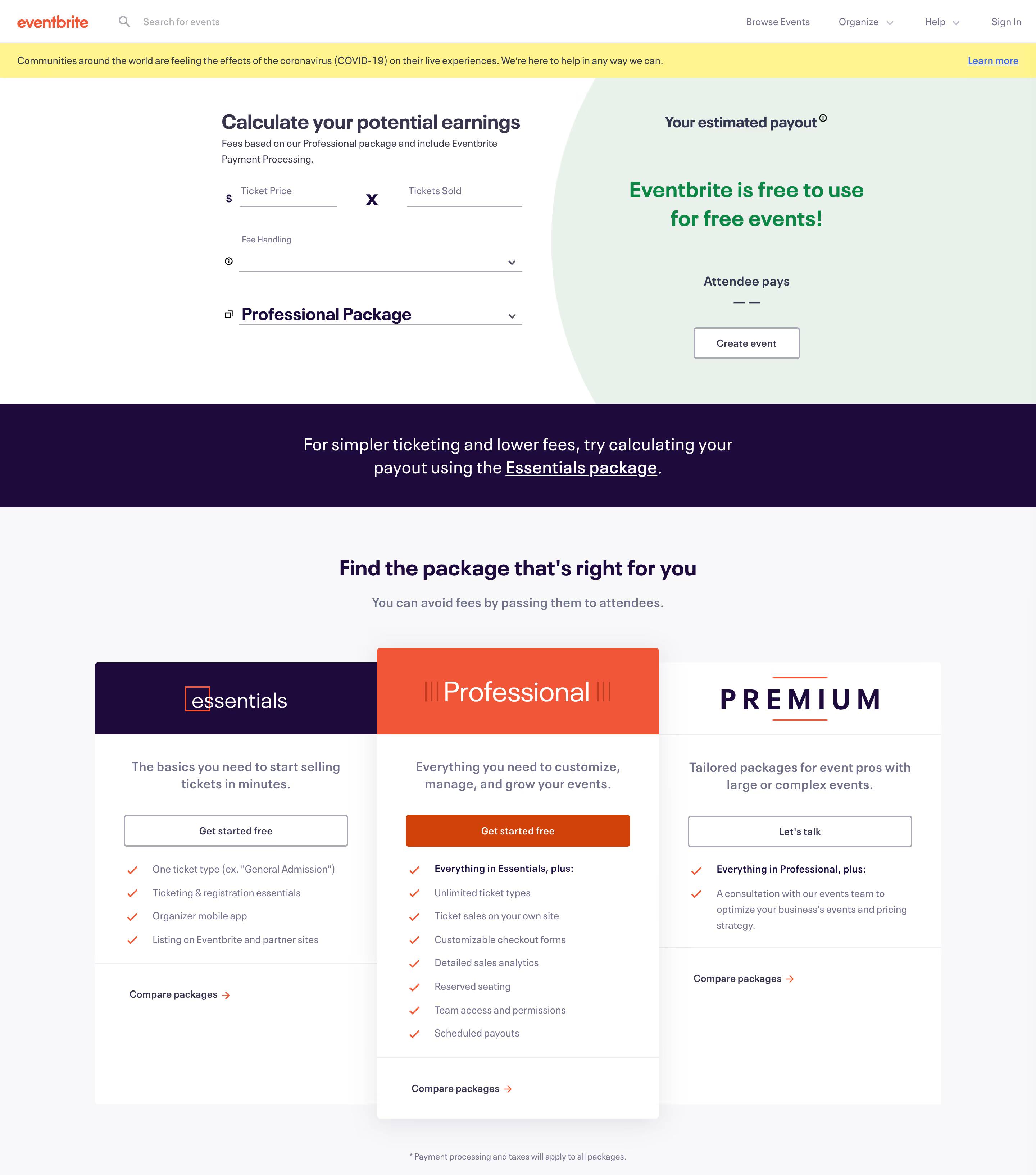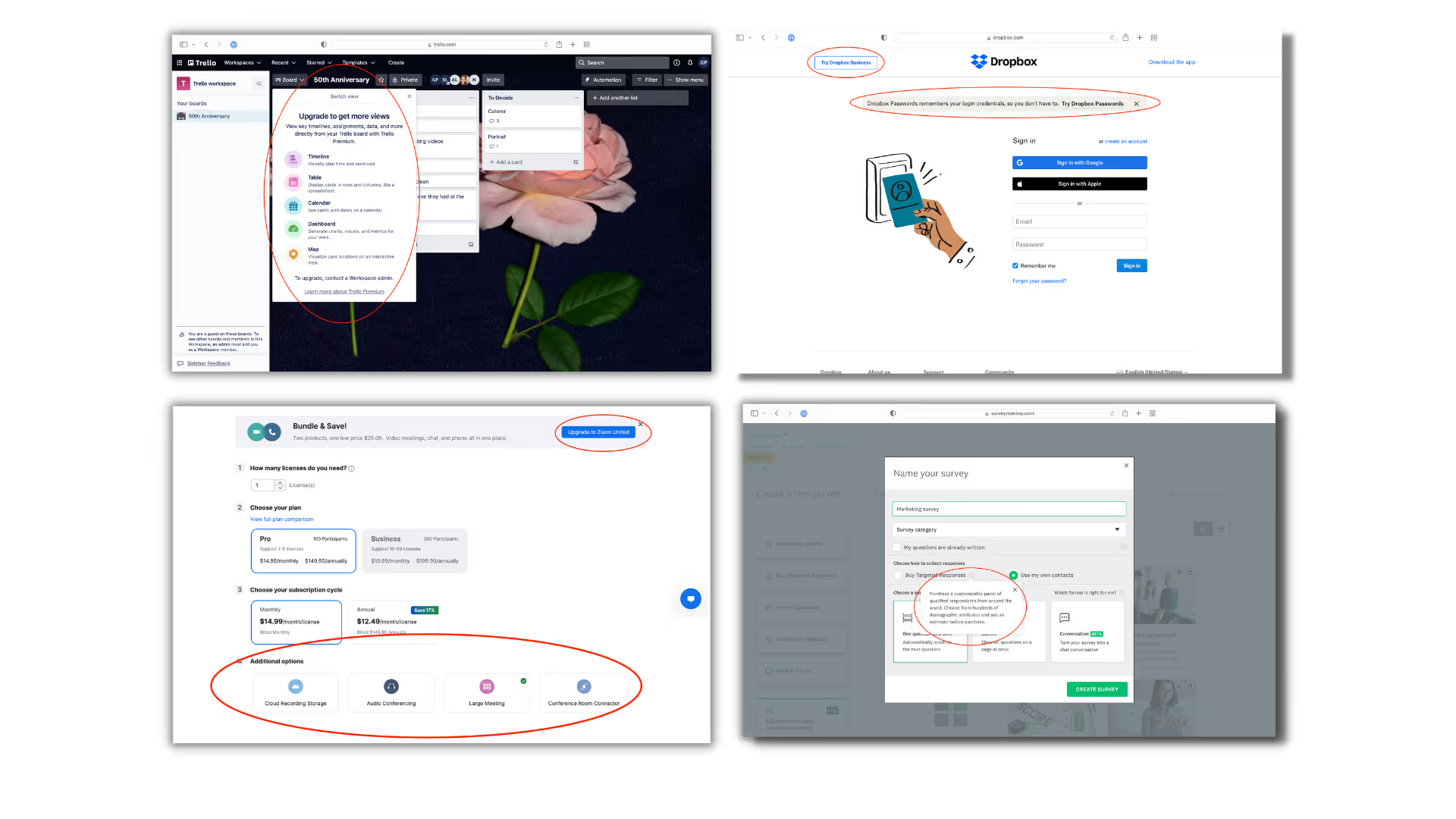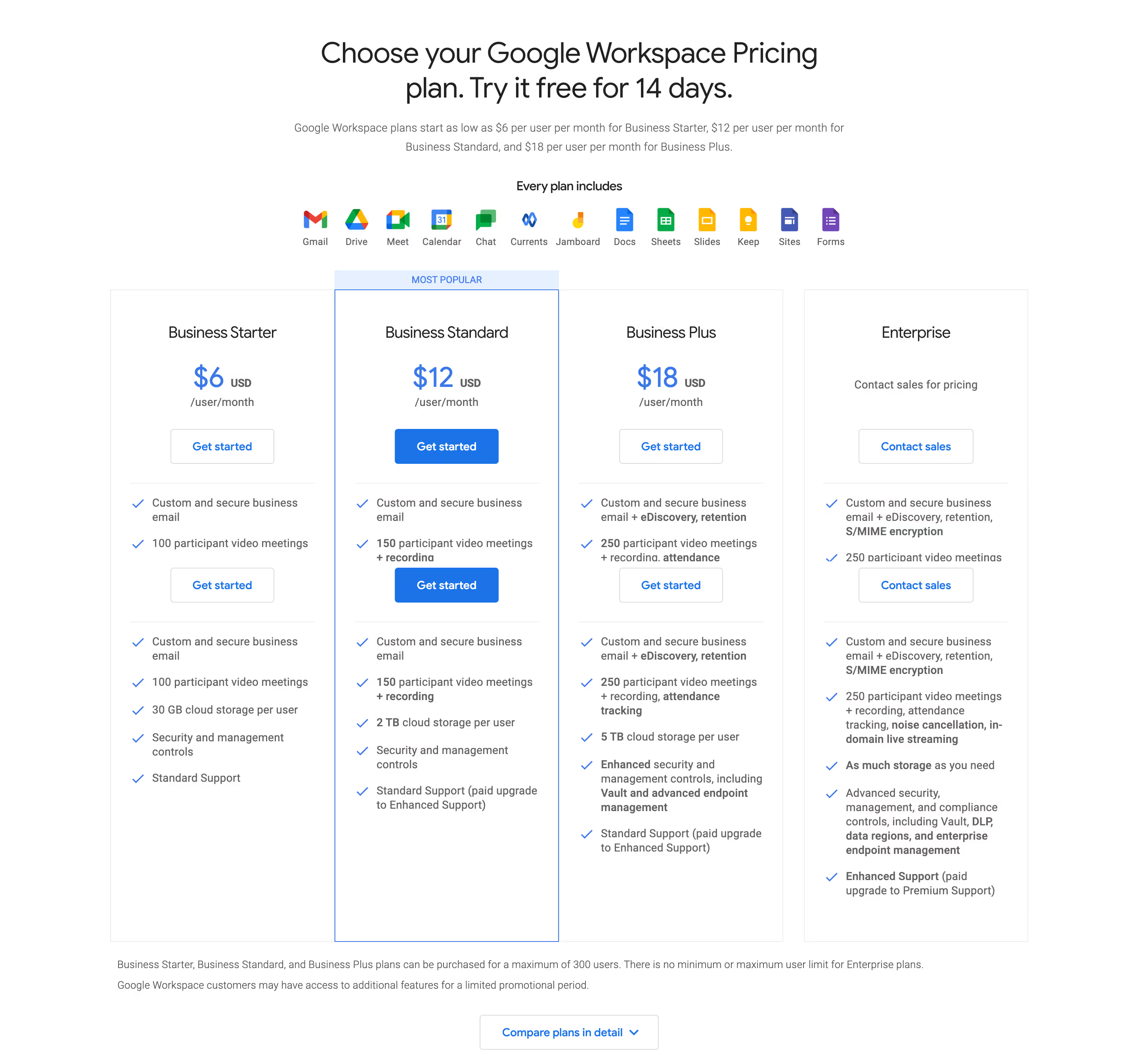Pricing: Bonus tactics
Now that you have the pricing fundamentals in place, here are a few additional tactics. If you think any are right for your startup, consider what questions you might add to your survey/interview template to implement them strategically. We'll finalize your survey/interview on the next page.
Bonus tactics discussed:
- Freemium and free trial
- Upgrades and add-ons
- Discounts and incentives
- Dynamic pricing
- Pricing page tips
Freemium and free trial
Both freemium and free trials are product-led growth tactics for customer acquisition. They help with conversion by reducing signup friction and getting users to experience your product’s JTBD faster.
There are plenty of reasons why both are popular.
- Free trials and freemium provide an opportunity to hook a prospect by delivering value before any money changes hands. When done right, by the time the user starts paying, they 1) understand how the product solves their problem, and 2) have developed a habit around product use.
- By analyzing data from thousands of SaaS and subscription companies, the ProfitWell team found that freemium cuts CAC by nearly half, and free trials had 15% lower CAC.
- The ProfitWell team also found an almost 20% improvement in net retention and a twice-as-good NPS score for freemium vs. non-free.
Those are all encouraging points, but they don’t mean you should definitely have a free offering. Freemium is tough to get right. Unless you understand your value metric really well, you run the risk of giving away either too much or not enough value in your product’s free version. It takes a lot of data to know how to strike the right balance.
Our upcoming discussion of model-market, model-product, and model-channel fits will help you determine whether freemium is right for your startup, but some indicators that it’s a good match are:
- Low product friction: Your product is easy to get started in and experience value from.
- Product stickiness: The value of your product increases the longer someone uses it, making them less likely to leave for a competitor—and giving you more time to convert them to paid.
- Network effects: Your product’s value increases as more people use it. Both stickiness and network effects help maximize user retention. And the longer someone is retained, the more likely they are to upgrade eventually.
- Product virality: Your product has pull virality and word-of-mouth potential.
- Self-service: You don’t need to put many resources toward supporting self-service users. They can experience product value without extensive training or support.
- Market competition: You’re offering an alternative to a well-entrenched competitor or introducing a totally new concept. Both might benefit from a freebie nudge.
- Market size: Your product would be able to convert enough people to make the economics work. Which means either a bigger market or a higher conversion rate. Market size is important for freemium because 1) you need a big market to truly go viral, and 2) freemium has a lower purchase rate than higher-touch models like sales.
Even if all the above are true, you should still do research to validate that a freemium version or free trial is right for your business. That might mean adding relevant questions to your survey. We’ve included a few examples in the project doc.
Also, those promising stats from ProfitWell notwithstanding, there is the potential for freemium / free trials to result in an increase in CAC and drop in retention. If you decide to offer freemium or a free trial, make sure it works with your CAC and ARPU and provides a clear conversion path. (We’ll discuss CAC and ARPU calculations in an upcoming section of this module.)
For helpful conversion benchmarks for freemium vs. free trial, check out this research by Ada Chen Rekhi.

Upgrades and add-ons
A common practice for SaaS tiered pricing is to integrate in-app upgrade triggers, for increased customer lifetime value (LTV). If a user is already in a product, and they run up against product limitations that would be resolved by an upgrade, they might go ahead and upgrade as an organic part of their user experience.
Some options for SaaS triggers:
- When a user attempts to access a higher-tier feature
- A banner or popup
- In-app CTAs and options
- Upgrades/add-ons at checkout

This is the same concept as upselling or cross-selling in ecommerce.
- Upselling: selling a higher-end version of a product
- Cross-selling: selling a related item
Two common places for ecommerce upsells and cross-sells are on product pages and in carts.

At left, product page upselling. At right, cart cross-selling.
Tip: Set up conversion tracking for any triggers you use, to see which ones result in upgrades. We’ll get into conversion tracking later in the Growth Program.
Discounts and incentives
Rule of thumb: Early-stage startups should avoid offering discounts. They can easily become a crutch or a Band-aid that’s covering up—and failing to solve—a bigger problem.
Often, that problem is wrong pricing—either because prospects don’t understand your product value, or they do understand it but can’t buy your product (e.g., because of a conversion or funnel issue), don’t feel the urgent need to, or don’t think your price is justified.
Plus, discounts can have a drastic effect on your product’s perceived value:
- If you discount your product too much, your market might think your product is cheap.
- If you discount your product too often, they might start to expect a discount. And they might end up either waiting until a discount becomes available—the opposite of the urgency you want—or flat-out refusing to buy your product without a discount.
That said, discounts and incentives can be effective, depending on your market. As with everything pricing-related, what matters is who’s doing the buying.
Example: Apple Store shoppers don’t typically buy based on discounts, but J.C. Penney shoppers do. The department store chain found that out the hard way when they brought an Apple exec in. He got rid of J.C. Penney’s discounts—and sales tanked.
If you’re considering experimenting with discounts and incentives, here are some guidelines to help you get started:
- Don’t offer more than 20-25% off.
- Make discounts random—in terms of both when the offer is made and what it is. That way, your audience won’t come to expect a discount.
- Use discounts in small doses. We don’t recommend starting off by offering discounts across your entire audience. That's inefficient, since many people who take advantage of them would probably be willing to pay your normal price. Focus on user segments that truly need a bit of a nudge.
- Remember that incentives encompass much more than just monetary discounts. Other forms they can take include product credits and rewards points (we discuss incentivized referral programs in the virality module). Ecommerce incentives span promotions, giveaways, limited-time specials, and free shipping.
- Finally—and most importantly—the best kinds of discounts are the ones that are deeply aligned with the product. They incentivize activation, habit building, and long-term use. Some examples:
- “Get 30% off if you buy 10 or more” is a more effective discount than “get 30% off your first order.” With the “first order” discount, the customer is only using the product once. It’s not habit-forming. (Plus, that discount will attract people who are likely to use it once, i.e., bargain shoppers.) The “buy 10 or more” offer means more product use, which increases the chance that the product’s true value will be realized.
- Free trials fit the bill too. By offering a 30-day free trial, you decrease friction and give prospects time to use your product, experience its core value, and build a habit around it.
- A discount on an annual vs. monthly subscription increases the chance that the user will get activated and build a product habit. You see this type of discount a lot on pricing pages, like Squarespace’s below.

Dynamic pricing
In our discussion of variable pricing earlier, we clarified that it’s not the same thing as dynamic pricing, which is when prices fluctuate based on market conditions. Examples include:
- Rideshare surge pricing
- Utilities costing more during times of high energy use
- Vending machine soft drinks having higher prices on hot days (an idea voiced by an executive at Coke—and quickly repudiated after internet backlash)
Dynamic pricing can mean profit maximization, since revenue is driven by supply, demand, and market trends. But because of its potential to alienate customers, we don’t consider it to be a top pricing technique.
We’re mentioning it here because it does work for some industries. When customers expect dynamic pricing—e.g., when booking flights or picking hotels—brand perception isn’t tarnished.
If you pursue dynamic pricing at your startup:
- Make sure you’re acting legally.
- Use a value metric.
- You’ll need to model out your pricing based on time, which might involve some higher-level computational/engineering prowess or the use of machine learning.
Pricing page tips
Here are some pricing page best practices to bear in mind:
- Keep it simple. Bells and whistles could add bottom-of-funnel friction. Keep design clean and copy minimal. Use high-contrast CTAs to make them unmissable.
- Include social proof. Social proof—such as testimonials, media mentions, or customer logos—affirms that your brand is trustworthy and your product is popular. When it’s on a pricing page, it can become the tipping point for on-the-fence prospects.
- Address objections. What are some common objections your prospects have? Many pricing pages have FAQ sections that address objections, to help prospects move forward with conversion. For example, Semrush’s pricing page has an FAQ section to explain their cancellation and refund policies and provide guidance on which plan to choose.
- Help prospects decide. For tiered pricing, one way to reduce analysis paralysis is by showing which plan is “recommended” or “most popular.” That tier might have a box around it or a different header color.
- Use scarcity and urgency. According to the scarcity effect, we value things more if they’re limited. Both scarcity and urgency compel prospects to act. Ways to add them: 1) show limited availability, 2) add a countdown (“sale ends in x days”), or 3) use scarcity language (“only 10 seats left”).
- Test tier order. Most pricing pages follow the order we read in in English: cheapest to priciest from left to right. Others use price anchoring: They show the highest price first (at left), so other tiers seem attractive in comparison. Our advice: Test both to see which has a higher conversion rate.



